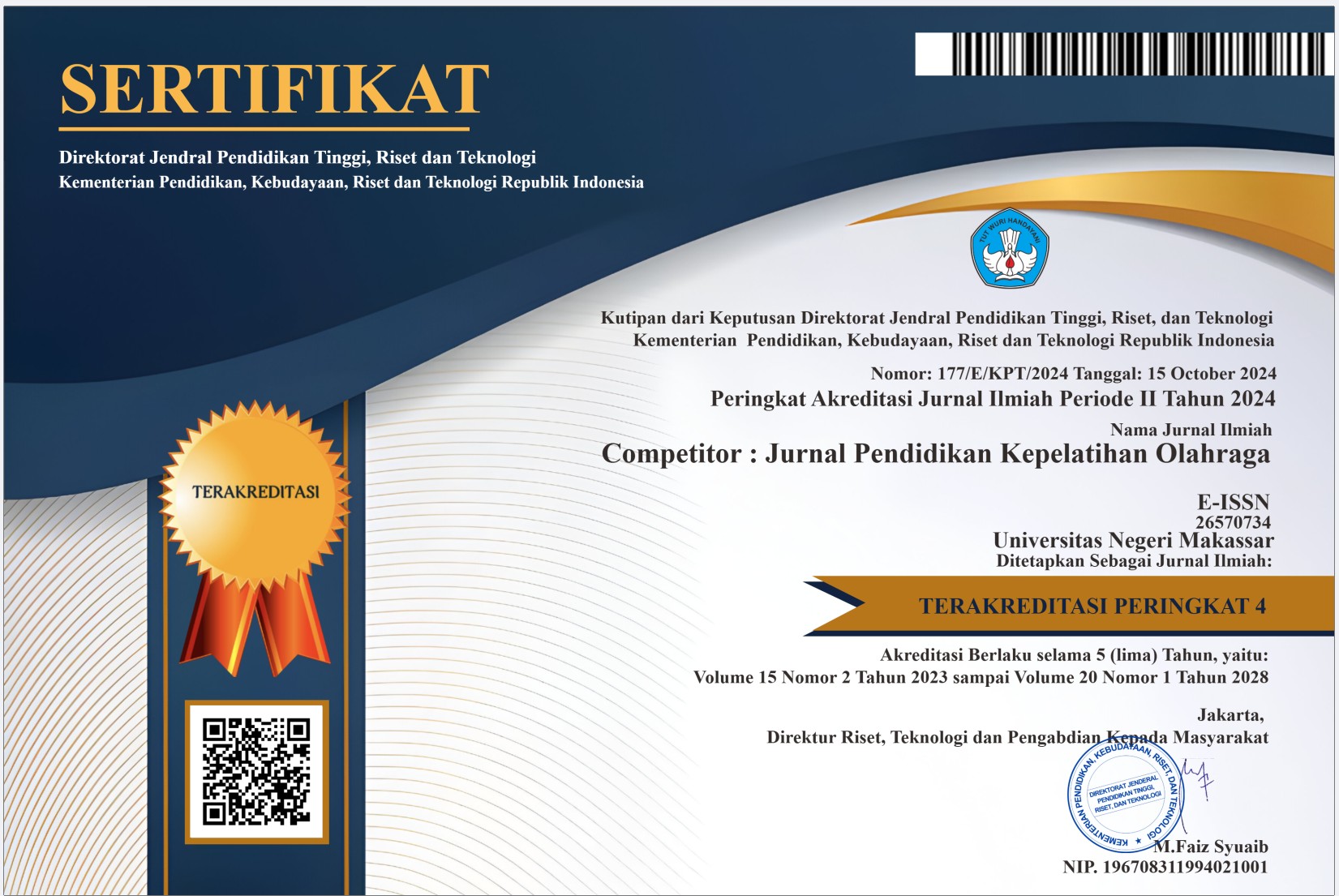The Relationship Between Recreational Exercise Frequency And Physical Fitness Level
DOI:
https://doi.org/10.26858/cjpko.v17i2.155Keywords:
Frequency; Exercise; Recreation; Physical Fitness Level.Abstract
This study aims to examine the relationship between the frequency of recreational exercise and physical fitness levels through a literature study of various scientific sources. Modern passive lifestyles have led to a decline in physical activity among the public, which contributes to declining fitness levels and increases the risk of non-communicable diseases. Recreational sport, as a voluntary and enjoyable physical activity, has been shown to improve various components of physical fitness if practised regularly. Analysing 10 scientific articles, the results of this study show that the frequency of recreational exercise is positively associated with improvements in physical fitness, including heart-lung endurance, muscle strength and flexibility. Recommendations from the WHO and various studies support the importance of doing at least 150 minutes of physical activity per week. Therefore, recreational exercise done consistently can be an effective solution to improve physical fitness. These findings emphasise the importance of building an exercise habit into daily life.
References
Fox, K. R., Biddle, S. J., & Edmunds, L. (2010). Physical Activity and Mental Well-being in Youth and Adults: A Review of Reviews. Journal of Sports Sciences.
Hidayat, T., & Ramadhan, D. (2019). Pengaruh Jalan Cepat Terhadap Kebugaran Jasmani Pegawai. Jurnal Olahraga dan Kesehatan, 7(1), 45–53.
Kemenkes RI. (2021). Profil Kesehatan Indonesia Tahun 2020. Jakarta: Kementerian Kesehatan Republik Indonesia.
Lestari, D., Putri, R. A., & Nugroho, A. (2020). Efektivitas Latihan Aerobik Terhadap VO2 Max Mahasiswa. Jurnal Ilmu Keolahragaan, 5(2), 101–109.
Nurhayati, S., & Rudianto, H. (2017). Pengaruh Senam Pagi terhadap Kebugaran Guru SD. Jurnal Pendidikan Jasmani, 3(1), 15–22.
Prasetyo, A., & Handayani, D. (2016). Pengaruh Aktivitas Bersepeda Terhadap Kesehatan Lansia. Jurnal Geriatri Indonesia, 10(3), 175–180.
Suharjana, S. (2014). Pengaruh Latihan Senam Kebugaran Jasmani Terhadap Siswa SMP. Jurnal Pendidikan Jasmani Indonesia, 10(1), 23–30.
Suroso, S. (2018). Hubungan Frekuensi Olahraga dengan Kebugaran Jasmani Mahasiswa. Jurnal Keolahragaan, 6(2), 80–88.
World Health Organization. (2020). WHO Guidelines on Physical Activity and Sedentary Behaviour. Geneva: WHO.
Yuliana, D. (2022). Dampak Senam Ringan Terhadap Energi Harian dan Keseimbangan Ibu Rumah Tangga. Jurnal Kesehatan Masyarakat, 14(1), 33–40.
American College of Sports Medicine. (2018). ACSM's Guidelines for Exercise Testing and Prescription (10th ed.). Wolters Kluwer.
Penedo, F. J., & Dahn, J. R. (2005). Exercise and Well-being: A Review of Mental and Physical Health Benefits Associated with Physical Activity. Current Opinion in Psychiatry, 18(2), 189–193.
Hill, J. O., & Peters, J. C. (2008). Environmental Contributions to the Obesity Epidemic. Science, 280(5368), 1371–1374.
Caspersen, C. J., Powell, K. E., & Christenson, G. M. (1985). Physical Activity, Exercise, and Physical Fitness: Definitions and Distinctions for Health-Related Research. Public Health Reports, 100(2), 126–131.
Van der Ploeg, H. P., Chey, T., Korda, R. J., Banks, E., & Bauman, A. E. (2012). Sitting Time and All-Cause Mortality Risk in 222,497 Australian Adults. Archives of Internal Medicine, 172(6), 494–500.
Thorp, A. A., Owen, N., Neuhaus, M., & Dunstan, D. W. (2011). Sedentary Behaviours and Subsequent Health Outcomes in Adults: A Systematic Review of Longitudinal Studies.American Journal of Preventive Medicine, 41(2), 207–215.
Dube, L., & Schwartz, R. (2015). The Impact of Physical Activity on Mental Health and Physical Functioning. American Journal of Health Promotion, 29(4), 264–275.
Trost, S. G., & Loprinzi, P. D. (2011). Exercise and Physical Activity in the Prevention and Management of Type 2 Diabetes. Current Diabetes Reports, 11(2), 235–241.
Blanchard, C. M., & Toguri, S. L. (2013). Physical Activity and Health: A Review of the Literature.
Journal of Physical Activity and Health, 10(3), 300–312.
Murtagh, E. M., Murphy, M. H., & Tully, M. A. (2015). The Effect of Walking on Physical and Mental Health Outcomes: A Review of the Literature. Preventive Medicine, 69, 87–93
Downloads
Published
Issue
Section
License
Copyright (c) 2025 Nur Kholilah Harahap, Rahmi Aulia, Andes Martua Harahap, Suci Amalia Lubis, Asnidar Cintya Siregar (Author)

This work is licensed under a Creative Commons Attribution 4.0 International License.





















